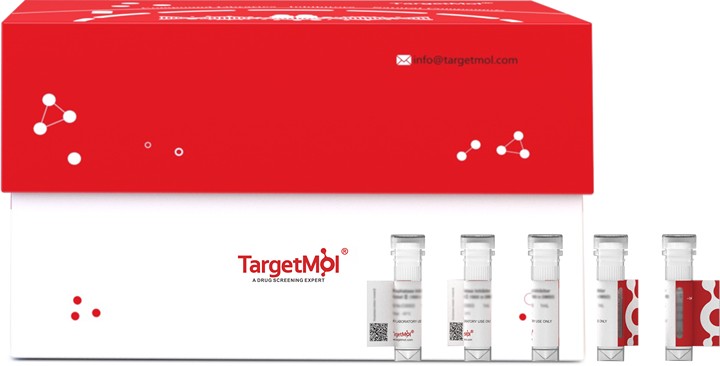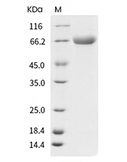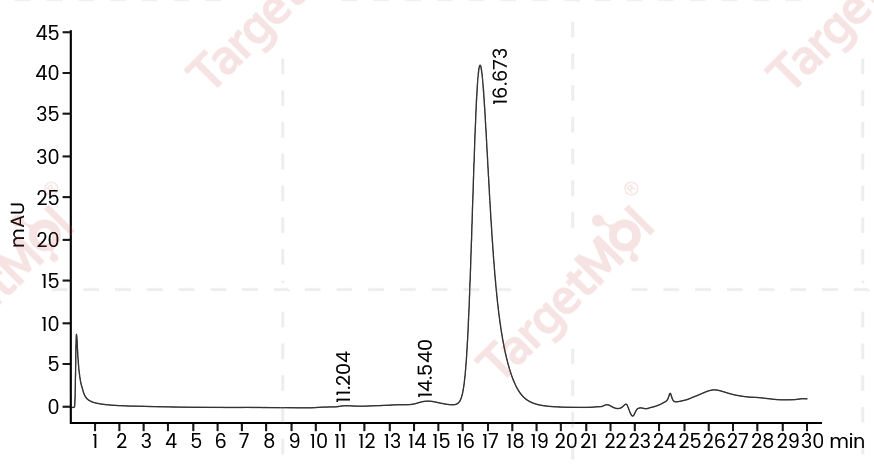- Remove All
 Your shopping cart is currently empty
Your shopping cart is currently empty
TLR4 Protein, Human, Recombinant (His)
TLR4, also known as TLR-4, is a member of the Toll-like receptor (TLR) family, which plays a fundamental role in pathogen recognition and activation of innate immunity. TLRs are highly conserved from Drosophila to humans and share structural and functional similarities. They recognize pathogen-associated molecular patterns (PAMPs) that are expressed on infectious agents, and mediate the production of cytokines necessary for the development of effective immunity. TLR4 is most abundantly expressed in placenta, and in myelomonocytic subpopulation of the leukocytes. TLR 4 has also been designated as CD284 (cluster of differentiation 284). It has been implicated in signal transduction events induced by lipopolysaccharide (LPS) found in most gram-negative bacteria. TLR4 Cooperates with LY96 and CD14 to mediate the innate immune response to bacterial lipopolysaccharide (LPS). It acts via MYD88, TIRAP and TRAF6, leading to NF-kappa-B activation, cytokine secretion and the inflammatory response. It is also involved in LPS-independent inflammatory responses triggered by Ni(2+).

TLR4 Protein, Human, Recombinant (His)
| Pack Size | Price | Availability | Quantity |
|---|---|---|---|
| 100 μg | $588 | In Stock | |
| 1 mg | $3,880 | 7-10 days |
Product Information
| Biological Activity | 1.Immobilized TLR4 Protein, Human, Recombinant (His) at 1 μg/mL (100 μL/well) on His Tag Antibody, Mouse MAb precoated (5 μg/mL, 100 μL/well) can bind Anti-TLR4 Antibody, the EC50 is 4-15 ng/mL (QC tested).
2.Immobilized Anti-TLR4 Antibody at 2 μg/mL (100 μL/well) can bind TLR4 Protein, Human, Recombinant (His), the EC50 is 4-15 ng/mL (Routinely tested). |
| Description | TLR4, also known as TLR-4, is a member of the Toll-like receptor (TLR) family, which plays a fundamental role in pathogen recognition and activation of innate immunity. TLRs are highly conserved from Drosophila to humans and share structural and functional similarities. They recognize pathogen-associated molecular patterns (PAMPs) that are expressed on infectious agents, and mediate the production of cytokines necessary for the development of effective immunity. TLR4 is most abundantly expressed in placenta, and in myelomonocytic subpopulation of the leukocytes. TLR 4 has also been designated as CD284 (cluster of differentiation 284). It has been implicated in signal transduction events induced by lipopolysaccharide (LPS) found in most gram-negative bacteria. TLR4 Cooperates with LY96 and CD14 to mediate the innate immune response to bacterial lipopolysaccharide (LPS). It acts via MYD88, TIRAP and TRAF6, leading to NF-kappa-B activation, cytokine secretion and the inflammatory response. It is also involved in LPS-independent inflammatory responses triggered by Ni(2+). |
| Species | Human |
| Expression System | Baculovirus Insect Cells |
| Tag | C-His |
| Accession Number | O00206-1 |
| Synonyms | toll-like receptor 4,TOLL,TLR-4,TLR4,CD284,ARMD10 |
| Construction | A DNA sequence encoding the human TLR4 (Met1-Lys631) (O00206-1) was expressed with a C-terminal polyhistidine tag. Predicted N terminal: Glu 24 |
| Protein Purity | ≥ 87 % as determined by SDS-PAGE. ≥ 90 % as determined by SEC-HPLC.   |
| Molecular Weight | 70.5 kDa (predicted); 68 kDa (reducing condition, due to glycosylation) |
| Endotoxin | < 1.0 EU/μg of the protein as determined by the LAL method. |
| Formulation | Lyophilized from a solution filtered through a 0.22 μm filter, containing 20 mM PB, 500 mM NaCl, pH 6. 0, 10% glycerol. Typically, a mixture containing 5% to 8% trehalose, mannitol, and 0.01% Tween 80 is incorporated as a protective agent before lyophilization. |
| Reconstitution | A Certificate of Analysis (CoA) containing reconstitution instructions is included with the products. Please refer to the CoA for detailed information. |
| Stability & Storage | It is recommended to store recombinant proteins at -20°C to -80°C for future use. Lyophilized powders can be stably stored for over 12 months, while liquid products can be stored for 6-12 months at -80°C. For reconstituted protein solutions, the solution can be stored at -20°C to -80°C for at least 3 months. Please avoid multiple freeze-thaw cycles and store products in aliquots. |
| Shipping | In general, Lyophilized powders are shipping with blue ice. |
| Research Background | TLR4, also known as TLR-4, is a member of the Toll-like receptor (TLR) family, which plays a fundamental role in pathogen recognition and activation of innate immunity. TLRs are highly conserved from Drosophila to humans and share structural and functional similarities. They recognize pathogen-associated molecular patterns (PAMPs) that are expressed on infectious agents, and mediate the production of cytokines necessary for the development of effective immunity. TLR4 is most abundantly expressed in placenta, and in myelomonocytic subpopulation of the leukocytes. TLR 4 has also been designated as CD284 (cluster of differentiation 284). It has been implicated in signal transduction events induced by lipopolysaccharide (LPS) found in most gram-negative bacteria. TLR4 Cooperates with LY96 and CD14 to mediate the innate immune response to bacterial lipopolysaccharide (LPS). It acts via MYD88, TIRAP and TRAF6, leading to NF-kappa-B activation, cytokine secretion and the inflammatory response. It is also involved in LPS-independent inflammatory responses triggered by Ni(2+). |
Dose Conversion
Sci Citations
Calculator
Tech Support

Copyright © 2015-2025 TargetMol Chemicals Inc. All Rights Reserved.


